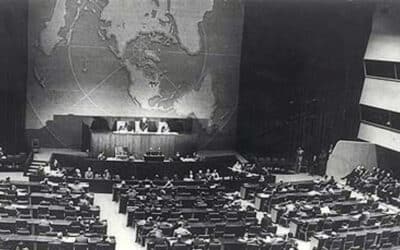Table of Contents
Introduction
Among active supporters of Palestinians’ rights, there is a strong popular tendency to reject what is known as “the two-state solution” in favor of a “one-state solution” to the Israel-Palestine conflict. However, this rejection is premised on the mistaken assumption that achieving the two-state solution was the goal of the now essentially defunct US-led so-called “peace process”. And the failure among Palestinian supporters to recognize this critical distinction is itself an obstacle toward a peaceful and just resolution.
The reality is that the goal of the “peace process” has never been to realize the two-state solution. And falsely equating the two has had the regrettable consequence of serving the interests of Israel’s occupation regime. It is, as the idiom goes, to throw out the baby with the bath water.
There are really two fundamental misunderstandings here: one about the two-state solution and the other about the “peace process”. These misunderstandings are a consequence of Zionist propaganda that has taken the form of common knowledge, but which is devoid of truth.
The US, of course, has always characterized its role in the “peace process” as benevolent and the process itself as being designed to achieve a two-state solution, but this must not be confused with the two-state solution. What must be recognized is that, while the latter is grounded in international law, the former is premised on a rejection of the applicability of international law toward a just resolution.
The True Meaning of Resolution 242
The Zionist propaganda at the heart of this confusion is Israel’s unilateral interpretation of United Nations Security Council Resolution 242, which interpretation has no validity under international law.
This resolution was passed in the wake of the June 1967 war, during which Israel occupied the Palestinian territories of the Gaza Strip and the West Bank, including East Jerusalem.
The US government and media—including, regrettably, alternative online publications supportive of Palestinians’ rights—routinely propagate Israel’s false claims about Resolution 242 as though representing its true meaning and the intent of the Security Council. By mistakenly equating the “two-state solution” with the “peace process”, Palestinian supporters are unwittingly propagating the Zionist myth about Resolution 242, which is immensely damaging to the Palestinians’ cause.
The misinformation centers around the Security Council’s call in that resolution for Israel to withdraw from the territories it occupied during the 1967 war. Israel’s ridiculous contention is that it was the will of the Security Council that Israel could retain some of the land it conquered during the war, and that Israel has no obligation to withdraw from occupied territory until a final peace agreement is reached that includes a final settlement on borders.
One of the foundational premises of the “peace process” is the US’s acceptance of Israel’s false interpretation as a framework for what have heinously been dubbed “negotiations”. Under this framework, the Palestinians must “negotiate” with their occupier while remaining under the thumb of the military occupation regime, and while Israel continues to prejudice the outcome of said “negotiations” with the continual expansion of its Jewish settlements constructed illegally within occupied territory.
The intended outcome of this US-led process is to force the Palestinians to surrender their rights to an extent deemed satisfactory by Israel. Under the US framework, Palestinians not only must surrender even more of their land to Israel, but also their right to return to their own homeland, from which a majority of them were expelled during the campaign of ethnic cleansing by which the “Jewish state” of Israel was established in 1948.
The governments of Israel and the US would have the world believe that this framework is grounded in international law. They even cite Resolution 242 as the basis for the “peace process”. But it is a twisted shadow of Resolution 242 that the “peace process” represents, not the principles of international law the resolution was intended to uphold.
The truth is that it was the unanimous will of the Security Council that Israel must completely and immediately withdraw its forces from Gaza and the West Bank, including East Jerusalem, in accordance with the principle of international law that the acquisition of territory by war is inadmissible.
I have expounded on this in my article “UN Resolution 242’s True Significance vs. Popular Zionist Myth”, which is adapted from an excerpt of my book Obstacle to Peace: The US Role in the Israeli-Palestinian Conflict, so I will not repeat my arguments here.
Suffice to say that powerful Zionist propaganda all too readily accepted by the US and other Western governments has achieved its desired effect. The Western media in turn also propagate the myth, casting a spell over the public mind. Even Palestinian supporters have been deceived into believing the myth over reality—not unlike how the related myth that the UN created Israel persists despite having no basis in fact.
It is time for this bewitchment to end.
The Goal of the So-Called “Peace Process”
It is upon the basis of that Zionist myth about Resolution 242 that the US-led so-called “peace process” was constructed. While the US has claimed to support a two-state solution, it has emphatically opposed the two-state solution.
This is something supporters of Palestinian rights must not continue to fail to understand. It is all well and good to reject the goal of the “peace process” along with the process itself. But it is a fundamental strategic mistake to equate the outcome desired by Israel and the US with the two-state solution.
Simply stated, the “peace process” is the process by which Israel and the US have long blocked implementation of the two-state solution.
In order to accomplish that aim, the “peace process” is premised on a fundamental rejection not only of Palestinians’ rights, but also of the applicability of international law toward finding a just resolution.
Hence the claim that Israel has repeatedly offered “concessions” to the Palestinians. For example, under the framework adopted by Western governments and media, if Israel is supposedly willing to “cede” such-and-such percentage of the West Bank to the Palestinians for their own state, this is dubbed a “concession”—even though legally none of this land is Israel’s to give, but is under international law rather defined as “occupied Palestinian territory”.
Actually, the vast majority of the world’s governments, as well as the United Nations organization, already recognize Palestine as an independent state. One of the few legitimate objections to such recognition is that Palestine doesn’t meet the definition of statehood since it doesn’t have legally defined borders, which is a requirement for statehood under the 1933 Montevideo Convention on the Rights and Duties of States. But, then, if Palestine shouldn’t be recognized as a state for that reason, then, by an equal measure, neither should Israel.
The description by the US media of past so-called “offers” from Israel as “concessions” rather than ultimatums is simply a reflection of the US government’s habit of rejecting international law so long as its application would be contrary to Washington’s policy aims. It is simply another illustration of how the mainstream media serve to manufacture public consent for US government policy. Other examples abound, such as the media’s description of East Jerusalem as “disputed” territory, even though it is a simple and uncontroversial point of fact under international law that East Jerusalem, too, is “occupied Palestinian territory”.
The point is that the single strongest weapon the Palestinians have on their side—the weapon most feared by both Israel and its superpower benefactor—is international law. By equating the goal of the “peace process” with the two-state solution and rejecting it on that basis, Palestinian supporters are in effect, albeit unwittingly, joining with the US and Israel in rejecting the path forward as determined by the application of international law. And that is a grave strategic error that must be recognized and corrected.
‘Two-State’ vs. ‘One-State’ Solution: A False Paradigm
The rejection among Palestinian supporters of the two-state solution does not rest only on the mistaken association of it with the goal of the “peace process”. It is also grounded in the realization that what the Arabs of Palestine wanted from the beginning was a single democratic state in which the rights of the minority would be respected, and that this outcome remains the most just one today.
However, to frame the issue as a choice between either the two-state solution or a one-state solution is a false paradigm. It is all well and good to speak of a single democratic state as a desired outcome, which would of course entail respecting the right of Palestinian refugees to return to their homeland. But how do we actually get there?
It is a common view among supporters of the global boycott, divestment, and sanctions (BDS) movement that the two-state solution is dead, never had any validity to begin with, and must be rejected in favor of the one-state solution. Yet the explicit goals of the BDS movement are as follows:
- Ending its occupation and colonization of all Arab lands and dismantling the Wall
- Recognizing the fundamental rights of the Arab-Palestinian citizens of Israel to full equality; and
- Respecting, protecting and promoting the rights of Palestinian refugees to return to their homes and properties as stipulated in UN resolution 194.
No doubt, for all three of these goals to be implemented would effectively mean the realization of a single democratic state. And yet, the most immediate of these goals, to see an end to Israel’s occupation regime, is in essence a call for the two-state solution to be finally implemented.
The two-state solution is not necessarily the end goal, but it is a required step along the path to be able to realize a single democratic state. Only once the occupation is ended will the Palestinians be able to gain the political leverage required to compel Israel to comply with international law, which will in turn be necessary if there is to be any realistic hope of Palestinian refugees exercising their right to return to their homeland.
The Path Forward
The actions called for by the BDS movement are tactics, but what is the strategy? Israel is not going to change its policies to align with the worthy goals of the movement simply on account of people at the grassroots level advocating these tactics. It is simply not realistic to expect that these tactics will cause Israeli policymakers to have a fundamental change of heart, formally annex Gaza and the West Bank, grant Israeli citizenship to the Palestinians, welcome Palestinian refugees home, and protect the equal rights of all under Israeli law. This is a wishful fantasy, not a strategy.
While popular grassroots movements are an important part of any struggle for liberty and justice against an oppressive state regime, to be truly effective, they must align with an overall pragmatic strategy.
There are essentially three main obstacles that must be overcome for a just peace to be realized. The first, of course, is Israel. But what the tactics employed by the BDS movement unfortunately overlook is that the obstacle of Israel’s persistent violations of Palestinians’ rights cannot be overcome without addressing the second main obstacle, which is the government of the United States.
Only once it becomes politically infeasible for the US government to continue its policy of supporting Israel’s crimes against the Palestinians will there be any hope of similarly making it politically infeasible for those crimes to continue.
While effecting the paradigm shift necessary for that change to occur is primarily the responsibility of the global community of activists, and especially the American people, the third main obstacle is one that must primarily be overcome by the Palestinian people themselves: their own leadership.
This, too, is an obstacle the BDS tactics unfortunately do nothing to address.
Two of the initial agreements underlying the “peace process” are the Oslo Accords, which established the Palestinian Authority (PA). The PA has long been under the leadership of Mahmoud Abbas, whose term as President actually expired nearly a decade ago. And Abbas has served his role well, inasmuch as the intended purpose of the PA under the Accords was to serve as Israel’s collaborator in enforcing its occupation regime. (See again my book Obstacle to Peace for documentation.)
Since the UN General Assembly recognized Palestine as an independent state in November 2012, the PA has had recourse to international legal mechanisms such as the International Court of Justice (ICJ) and the International Criminal Court (ICC). It is very telling that the PA has to date made almost no effort to pursue legal remedy through such mechanisms. (What few steps it has taken it has pursued only halfheartedly.)
Given its purpose under the Oslo Accords, it would seem a prerequisite that the PA be dissolved and the Accords be withdrawn from in order for the Palestinians to move forward. The Palestine Liberation Organization (PLO) as the PA’s parent body has the authority to do that. But such a move would require a unified leadership, and Israel and the US have to date masterfully utilized a “divide and conquer” strategy.
Hamas won legislative elections in 2006, and its success was in no small part due to its criticisms of the corruption within the PA and the willingness of Abbas and his party, Fatah, to surrender Palestinians’ rights by giving in to Israel and the US’s ultimatums.
As I also document in Obstacle to Peace, the US and Israel’s response to Hamas’s victory was to conspire with Abbas to illegally overthrow the Hamas government. The result was a full rending of the political leadership, with Hamas remaining in power in Gaza, but Abbas’s regime controlling the West Bank.
Israel also escalated its longstanding blockade of Gaza into a full scale siege of the narrow strip of land, with the goal of punishing the entire civilian population living there for the crime of having Hamas as their leadership.
Any successful strategy toward realizing a just solution must include achieving the necessary unity among the Palestinians’ political leadership. There have repeatedly over the years been on-and-off talks about reconciliation between Fatah and Hamas, but these have never gained much traction, primarily due to the obstinance of the PA.
The outcome of the last such effort was Abbas successfully urging Israel to escalate its collective punishment of Gazans by cutting off electricity that it is legally obligated as Occupying Power under the Fourth Geneva Convention to ensure the supply of.
Establishing a unity of purpose among Palestinian leaders is a necessity. And that purpose must be to cease collaborative efforts with the Occupying Power and instead pursue legal remedy for Israel’s violations of international law through the international institutions now available to the Palestinians.
When Israeli leaders become afraid to go outside of the territory under Israel’s control for fear of being arrested for war crimes, then an end to the occupation will finally be in sight.
While there are reasons to believe that the tide is turning, there yet remains a long, hard struggle ahead for the Palestinians. For those of us who support them in their struggle for liberty and justice to be effective in our own efforts, we must, too, be unified in strategy. And for any strategy to have hope of success, it must include recognition of the reality that there is no realistic alternative path around the two-state solution to the one-state goal.
I myself have argued in the past that the two-state solution is dead, and that a single democratic state is the only just solution. While I did not at that time make the mistake of equating the two-state solution with the goal of the “peace process”, I did fail to recognize that it is not an endgame in itself, but a necessary step. I have since recognized the error in my thinking, which evolved considerably during the process of researching and writing Obstacle to Peace: The US Role in the Israeli-Palestinian Conflict, which I wrote primarily to empower those who are active in the struggle with the knowledge needed to effect the paradigm shift that is necessary to eliminate this particular obstacle.
Those who support Palestinians’ rights must not make the mistake of believing and propagating the lie that the goal of the “peace process” they rightly reject has been to establish the two-state solution. On the contrary, the goal of the “peace process” has always been to prevent that outcome. It is not the two-state goal, but the evil, lawless distortion of it that is the problem. And while the two-state solution may not in itself be the ideal outcome, there is no realistic alternative to it as a required step along the path toward a single democratic state respecting the equal rights of all its citizens.
So when you think of the two-state solution, don’t think of the goal of the “peace process”. Instead, understand that implementation of the two-state solution is practically synonymous with ending the occupation, which is precisely what the “peace process” was intended to prevent.
This article was originally published at Foreign Policy Journal.



